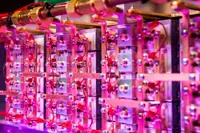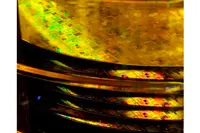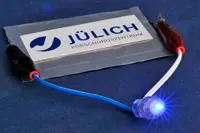Electronics News
Archive : 13 March 2015 год
 The US Lawrence Livermore National Laboratory (LLNL) has installed and commissioned an array of laser diodes with a peak power of 3.2MW. The diode arrays are a key component of the High-Repetition-Rate Advanced Petawatt Laser System (HAPLS). When completed, HAPLS will be installed in the European Union's Extreme Light Infrastructure (ELI) Beamlines facility in the Czech Republic.
The US Lawrence Livermore National Laboratory (LLNL) has installed and commissioned an array of laser diodes with a peak power of 3.2MW. The diode arrays are a key component of the High-Repetition-Rate Advanced Petawatt Laser System (HAPLS). When completed, HAPLS will be installed in the European Union's Extreme Light Infrastructure (ELI) Beamlines facility in the Czech Republic.
HAPLS is designed to generate peak powers of more than 1PW (1015W) at a repetition rate of 10Hz and with each pulse lasting 30fs.To develop these diode arrays, LLNL partnered with Lasertel, a developer of high-powered semiconductor laser pump modules, which combined advanced semiconductor laser technology with novel micro optics.
"We are thrilled to be working with LLNL, which continues to push the boundaries for high-energy laser systems," said Lasertel president Mark McElhinney. "Our collaboration has enabled several new benchmarks for laser performance to be set in a remarkably short period of time.
Previously, high energy, scientific laser systems used so called flashlamp technology, in which intense flashes of white light 'pump' laser active atoms to higher energy states.
"Flashlamp technology for lasers has been around for more than 50 years, and we've pretty much pushed the limits of that technology," said Andy Bayramian, HAPLS systems architect. "We've closed the books on flashlamps and started a new one with these laser diode arrays, enabling a far more advanced class of high energy laser systems."
In addition, LLNL needed to develop a completely new type of pulsed-power system in order to drive the diode arrays. The system draws energy from the grid and converts it to extremely high current, precisely shaped electrical pulses. Each power supply is capable of driving 40kA.
Author
Graham Pitcher
Source: www.newelectronics.co.uk
 In a move intended to increase the competitiveness of its industrial partners, CEA-Leti has launched the Silicon Impulse IC design competence centre. According to the French research organisation, Silicon Impulse will offer IC design services, advanced IP, emulation and test services, as well as multiproject wafer shuttles.
In a move intended to increase the competitiveness of its industrial partners, CEA-Leti has launched the Silicon Impulse IC design competence centre. According to the French research organisation, Silicon Impulse will offer IC design services, advanced IP, emulation and test services, as well as multiproject wafer shuttles.
In a move intended to increase the competitiveness of its industrial partners, CEA-Leti has launched the Silicon Impulse IC design competence centre. According to the French research organisation, Silicon Impulse will offer IC design services, advanced IP, emulation and test services, as well as multiproject wafer (MPW) shuttles.
CEA-Leti's CEO Marie-Noëlle Semeria said: "Silicon Impulse helps Leti's partners to introduce innovative products that deliver optimal performance and to benefit from the most advanced technologies."
Silicon Impulse will offer access to expertise in analogue, RF, digital and memory design and hardware/software integrated solutions at the technology node that meets the needs of each project most cost effectively. In particular, the centre will offer access to Fully Depleted Silicon-on-Insulator (FD-SOI) technology, as well as other advanced technologies such as ReRAM, MEMS, 3DVLSI and silicon photonics.
Semeria added: "With Silicon Impulse's one stop shop platform, 28nm FD-SOI heterogeneous, low power design becomes a reality for the IoT community."
Author
Graham Pitcher
Source: www.newelectronics.co.uk
 The merger between Cypress and Spansion has been completed ahead of schedule, creating a company that will be the third largest supplier of memories and MCUs to the automotive industry.
The merger between Cypress and Spansion has been completed ahead of schedule, creating a company that will be the third largest supplier of memories and MCUs to the automotive industry.
Cypress' president and CEO TJ Rodgers, pictured, said: "The new Cypress will capitalise on its expanded product portfolio and leadership positions in embedded processing and specialised memories to significantly extend its penetration of global markets, such as automotive, industrial, consumer, wearable electronics and the Internet of Things."
Rogers said Cypress has a dominant position in supplying the automotive sector with capacitive touch sensing controllers and SRAMs for infotainment systems, while Spansion is the leading supplier of flash and MCUs. "The new Cypress will be the number three chip supplier worldwide of memories and microcontrollers to this business," Rogers added. "You can think of the post merger company in terms of the well known equation 1 + 1 = 3 – number one in SRAMs, number one in NOR flash and number three overall."
Author
Graham Pitcher
Source: www.newelectronics.co.uk
 Scientists from Forschungszentrum Jülich have developed a prototype solid state lithium ion battery which is said to have an improved interface between solid electrolyte and electrodes. The cell, said to be the forerunner of a new generation of such devices, has been charged and discharged in the laboratory more than 350 times.
Scientists from Forschungszentrum Jülich have developed a prototype solid state lithium ion battery which is said to have an improved interface between solid electrolyte and electrodes. The cell, said to be the forerunner of a new generation of such devices, has been charged and discharged in the laboratory more than 350 times.
Lithium-ion batteries are currently the technology of choice, especially for mobile devices, because of their high energy density. However, the liquid electrolyte exposes them to problems such as leaking, overheating, burning and toxicity.
"The cells cannot catch fire and do not leak in accidents and errors. You can have [batteries with] a much longer life and which are less sensitive to temperature," said Professor Olivier Guillon from Jülich's Institute of Energy and Climate Research.
The electrolyte has to allow lithium ions to pass from anode to cathode during discharge and to isolate the two poles. Suitable solid materials need to have voids in their atomic lattice structure, which lithium ions can use to 'hop' through the solid.
"However," said Dr Sven Uhlenbruck, "the mechanism is slower than the diffusion processes within a liquid electrolyte. This increases the resistance to ion transport, reducing the retrievable power density of the battery. This poorer conductivity can be corrected, in principle, with a thin layer of the electrolyte. Our goal is to reduce the thickness of the solid electrolyte to a few microns."
A greater technical difficulty is said to lie in the design of the interface between the fixed electrodes and the solid electrolyte. A liquid electrolyte can work effectively with fine structured electrodes, but two adjacent solids present a different problem and the contact resistance between electrode and electrolyte is correspondingly higher. "By matching the production processes, we have managed to reduce the total internal resistance of the cell from 20k?/cm2 to 2k?/cm2," said Dr Uhlenbruck.
Author
Graham Pitcher
Source: www.newelectronics.co.uk

